 Bats in the Attic? Why DIY Bat Removal Can Backfire
Bats in the Attic? Why DIY Bat Removal Can Backfire
Bats in the Attic? Why DIY Bat Removal Can Backfire
It happens more often than you think: you might notice squeaking or flapping sounds coming from your attic space, or you might spot large piles of bat droppings inside your attic insulation. These are the common indicators of bats nesting inside your attic space. Many might have the impulse to try and deal with a bat problem themselves, but this isn’t recommended. Not only can DIY bat removal be ineffective and dangerous, it might also be illegal. Don’t worry, Westchester Wildlife can help. Our team of experts offer safe, humane bat removal services in the Westchester, NY area, in accordance with federal and state guidelines. Get in touch with our team today to get started at (800) 273-6673!
Understanding Bat Behavior in the Home
Attic spaces are particularly attractive to bats because they provide the perfect environment for roosting. Similar to the caves that bats naturally root in, attic spaces are warm, safe, and protected from predators and harsh elements. Some of the common species of bats that may nest inside your attic include the Little Brown Bat and the Big Brown Bat. You may notice a bat problem in your home when you hear flapping, scratching, or squeaking sounds at dusk. Stains around entry points caused by the bat’s greasy fur brushing against the siding can also be spotted. If you enter the attic space and see droppings inside your insulation, then you most likely have a bat problem.
The Role of Maternal Colonies (Why Summer Removal Is Off Limits)
A maternal colony is a group of female bats that roost together to raise pups. Maternal colonies usually get together to raise their pups from the late spring to late summer months of May to August. After the pups are born, it takes them several weeks to learn how to fly, and during this time they are totally reliant on their mothers. Removing bats during this time is prohibited by law, as attempting to remove the colony can kill the babies by trapping them inside the attic space. The mother bats may also re-enter your attic through new entrances to retrieve their pups.
Why Bats Are Federally Protected (And What That Means for You)
Bats are under federal and state protection, and attempting to remove them during maternity season can incur heavy fines. But why are bats protected? Well, there are a few reasons:
To start, bats are crucial to the ecosystem. Not only are they a natural pest control agent (bats can eat thousands of mosquitoes and crop pests nightly), but bats are also prominent pollinators for fruits and seeds that are an important part of our food chain.
Bats are also facing several challenges leading to population decline. A fungal disease called white-nose syndrome has been decimating bat populations, in part to how quickly it can spread among colonies. Natural habitats for bats have also been lost over the years as urban development and deforestation continues. Therefore, federal and state protections and guidelines were implemented to ensure that bats are always handled with care, to ensure the ongoing health and safety of these crucial critters.
The Right Way To Handle A Bat Problem
- Step 1: Professional inspection: contact the experts at Westchester Wildlife for a comprehensive inspection to confirm species, colony size, and access points.
- Step 2: Timing exclusion properly: our experts won’t begin exclusion until after the bat pups can fly, usually around August through October.
- Step 3: Use of one-way exclusion devices, which allow bats to leave the attic, but not get back inside.
- Step 4: sealing all entry points after exclusion is confirmed successful
- Step 5: guano cleanup to prevent the risk of histoplasmosis transmission
Why DIY Bat Removal Often Fails
DIY bat removal can often fail, as DIYers may unknowingly seal bats inside the home, or even worse, separate mothers and pups. If a DIYer is inexperienced in checking for entry points, they may misidentify the entry points, which would allow the bats to return or relocate to somewhere else within the structure. Store-bought repellents and strobe lights often don’t work, and might put further stress on the colony. Attempting to remove the bats by hand is NEVER recommended, as bats can bite or scratch, and these critters are a prevalent carrier of the rabies virus.
Trust the Experts at Westchester Wildlife
If you need bat removal in Westchester, contact the experts at Westchester Wildlife today! Our team has years of experience with humanely evicting bats from both residential and commercial properties, in accordance with state and federal laws. Our team ensures safe cleanup services and long-term exclusion success, protecting your home against bat invasions in the future. Contact our team today at (800) 273-6673 to get scheduled for a bat removal inspection in the Westchester area!
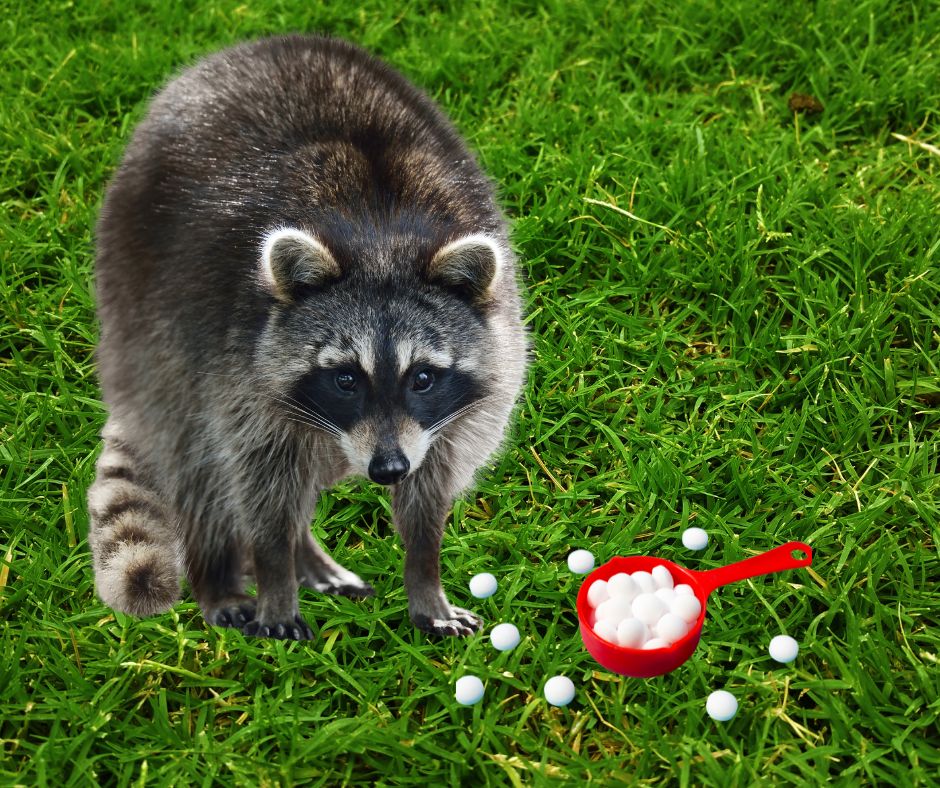 Do Mothballs Really Keep Animals Away?
Do Mothballs Really Keep Animals Away?
Do Mothballs Really Keep Animals Away?
Many homeowners rely on household hacks or false information to deter nuisance wildlife, but does it really work? For example, mothballs are commonly touted as a great way to get rid of raccoons, squirrels, snakes, skunks and other nuisance wildlife that may be causing issues, but there is little scientific evidence that mothballs actually do anything against these critters. Many wildlife repellents available on the market are ineffective, or only effective for a short period of time. The best way to keep animals off your property is to reduce attractants like food sources, seal any potential entry points, and install wildlife barriers around target areas like underneath decks. If you already have wildlife causing problems on your property and you need to get rid of them, contact the experts at Westchester Wildlife today for expert wildlife trapping and removal services at (800) 273-6673!
The Myth of Mothballs
Mothballs are small balls of chemical pesticides that are often used to prevent damage from silverfish, mold, and moth larvae when storing clothes and other fabric materials for long periods of time.
Popular DIY advice and word-of-mouth has led many to believe that the strong odor of mothballs is effective at repelling nuisance wildlife. However, there is little evidence for this. Mothballs may provide a short-term deterrent, but once the critters wisen up, they stop being effective. Mothballs are best used against clothing pests indoors, when they are put outdoors, the dilution caused by weather and the open air can lessen the effect. Mothballs shouldn’t be used outdoors anyways, as they can create health hazards when they contaminate soil and water. Mothballs may also harm non-target wildlife like birds, or pollinators like bees.
Other Common Wildlife Repellent Myths
Besides mothballs, there are a few other common myths about how to repel moths:
- Ammonia-soaked rags: temporary at best, often ignored by raccoons/skunks.
- Ultrasonic devices: inconclusive evidence; some animals adapt quickly
- Predator urine: often ineffective unless refreshed constantly and sourced properly.
- Irish Spring soap, peppermint oil, dryer sheets: mostly anecdotal, rarely backed by data.
What Actually Works?
You might be wondering, “If mothballs, predator urine, and ultrasonic devices aren’t effective, then how DO I keep animals away from my property?” Well, the answer is a combination of exclusion, habitat modification, and professional removal services.
Exclusion is the process of sealing off your home to ensure that critters can’t get inside. Exclusion can include sealing off entry points, installing chimney caps and vent guards, and weatherstripping underneath doors and windows. Crawl space encapsulations and crawl space vent sealing are another form of exclusion.
Habitat modification includes the steps you take to make your property less inviting to wildlife. Sealing trash cans, bringing in pet food at night, trimming vegetation attractive to critters, removing clutter and lawn debris, etc. are all examples of habitat modification.
Professional and humane wildlife removal services including trapping and removal services as well as deterrents can ensure that critters stay away from your property.
Wildlife Exclusion and Deterrents in Westchester
Don’t waste time on mothballs or other ineffective and risky DIY methods to keep raccoons, squirrels, skunks, snakes and more off your property. Instead, contact the experts at Westchester Wildlife for safe, humane wildlife removal, wildlife exclusion, and wildlife deterrents in Westchester at (800) 273-6673!
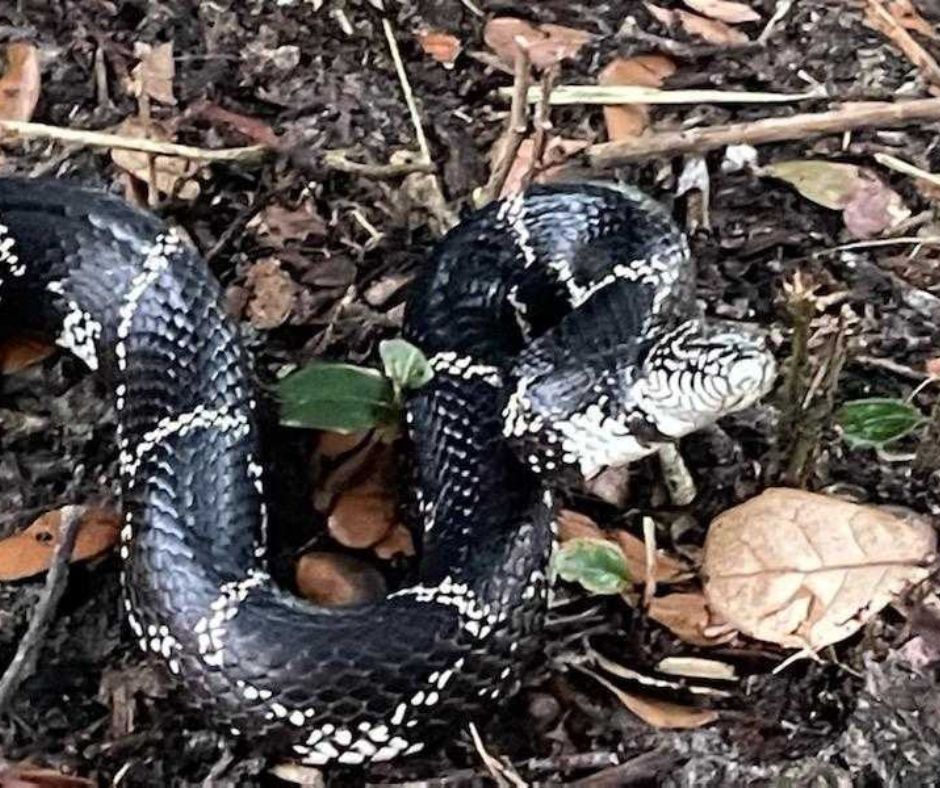 What Attracts Snakes to Homes in Westchester?
What Attracts Snakes to Homes in Westchester?
What Attracts Snakes to Homes in Westchester?
Do you have a problem with snakes inside your crawl space, attic, or garage in Westchester? While most snakes in the area aren’t venomous, that doesn’t mean homeowners are ready to let these reptiles into their homes. But what actually attracts snakes to your property? And how can you get rid of them?
Top Reasons Why Snakes Are Attracted to Residential Areas
- Abundant food sources: residential neighborhoods often have large populations of small rodents that snakes prey on, like mice, rats, and chipmunks. Outdoor bird feeders can also attract these rodents to residential areas.
- Shelter and hiding spots: snakes have plenty of places to hide and rest in residential areas, including wood piles, rock crevices, overgrown gardens, crawl spaces, sheds, garages, and gaps underneath decks or porches.
- Moisture and water: residential areas provide sources of water and moisture like bird baths, ponds, leaky garden hoses, and shady, damp areas in mulch beds.
- Yards with minimal activity: yards without pets, yards that aren’t mowed frequently, and yards with low foot traffic offer an undisturbed area where snakes feel safe.
Why Do Snakes Enter Homes?
Snakes will enter the house when they are searching for prey like mice and rats, which is why a snake inside your home is often an indicator of a larger issue with rodents. Snakes will also get inside crawl spaces during the cooler months, as they are attracted to the heat given off by the foundation.
Snakes can enter homes through cracks in the foundation, gaps underneath the garage door, open vents, or entry points created by other wildlife like raccoons and squirrels.
How to Make Your Property Less Inviting to Snakes
You can make your home less inviting to snakes by taking the proper precautions, including:
- Seal all entry points, including gaps and cracks in the foundation and siding. Install weatherstripping around doors and windows.
- Keep the yard clean by removing dead logs, leaf litter, woodpiles, etc. Trimming grass and shrubs near the home can also keep snakes out.
- Limit accumulation of water with proper drainage systems
- Contact a professional like Westchester Wildlife for rodent control services to limit the snake’s food population.
Snake Removal Services in Westchester
If you are seeing snake skins left around your property, or have seen snakes slithering around your garage or porch, don’t panic! Contact the experts at Westchester Wildlife! Our team of snake experts will safely locate and remove all snakes from your property, seal off all the entry points to prevent them from coming back, and institute a rodent control program to make your home even less attractive to snakes in the future. Contact our team to get started today with a FREE estimate at (800) 273-6673!
 What’s The Difference Between Mice, Moles, Voles, and Shrews?
What’s The Difference Between Mice, Moles, Voles, and Shrews?
What’s The Difference Between Mice, Moles, Voles, and Shrews?
Mice, moles, voles, and shrews are all common small mammals that can become a nuisance for homeowners in the Westchester, NY area. It’s important to be able to tell the difference between these nuisance critters, because each creates a specific type of damage, and each may require different methods of removal.
Mice
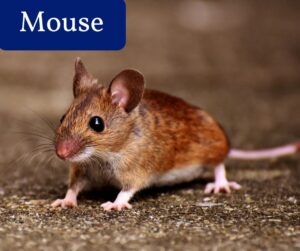 Mice are small rodents with prominent front teeth, long tails, slender bodies, and large ears. Out of all of these animals, mice are the ones that you will find indoors the most often. Mice will raid your kitchen pantry for dry, prepackaged food, tunnel through your attic insulation, and build nests in your basement.
Mice are small rodents with prominent front teeth, long tails, slender bodies, and large ears. Out of all of these animals, mice are the ones that you will find indoors the most often. Mice will raid your kitchen pantry for dry, prepackaged food, tunnel through your attic insulation, and build nests in your basement.
You can often tell if you have a mice infestation by seeing their small droppings around the house, especially in the kitchen, or smelling a strong urine odor. Gnaw marks on food packaging, baseboards and doors are also a sign of mice, as is scratching and running sounds coming from your attic space or inside your walls.
Mice can gnaw through wires and chew on wooden support beams and other structures in your home, so these rodents are most often associated with internal damage to the home, while moles, voles, and shrews are more associated with external damage to the home.
Moles
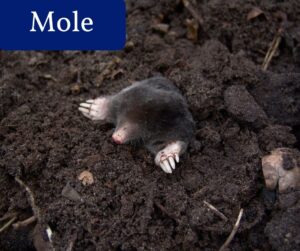 Moles are the most distinctive critter here, with cylindrical bodies, large front paws armed with long, sharp claws for digging, extremely small eyes, and no visible ears. Moles live underground, digging out large tunnels throughout your yard and feeding on earthworms, grubs, and other insects.
Moles are the most distinctive critter here, with cylindrical bodies, large front paws armed with long, sharp claws for digging, extremely small eyes, and no visible ears. Moles live underground, digging out large tunnels throughout your yard and feeding on earthworms, grubs, and other insects.
Moles can kill your lawn by tunneling through the soil underneath, disrupting the soil and destroying the root system of your grass. Moles can do the same inside your garden, killing vegetables as well as flowers and bushes. Unlike mice, you almost never find a mole inside your home. Some common signs of moles on your property include volcano-shaped mounds of dirt near the entrance to their tunnels, and raised ridges in the lawn that correspond to where they are digging underneath.
Voles
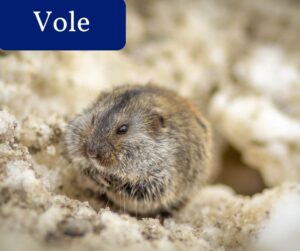 Voles are closely related to mice, often called “meadow mice” or “field mice”, but there are some key differences that set them apart. Voles are chubbier and stockier than mice, as opposed to the slimmer build that mice often have. While mice have long tails and big ears, voles have short tails and small ears. Mice more commonly get inside the house, but voles are commonly yard pests. Voles can live above or below ground, and stay active-year round. Voles are herbivores that feed on grass, roots, and bark. You can tell when you have a vole problem by spotting small surface runways, similar to tiny trenches, dug out through your yard. Spotting chewed bases of your plants and stripped bark can also indicate a vole problem. It’s important not to ignore voles, as they can destroy your garden and damage trees and shrubs.
Voles are closely related to mice, often called “meadow mice” or “field mice”, but there are some key differences that set them apart. Voles are chubbier and stockier than mice, as opposed to the slimmer build that mice often have. While mice have long tails and big ears, voles have short tails and small ears. Mice more commonly get inside the house, but voles are commonly yard pests. Voles can live above or below ground, and stay active-year round. Voles are herbivores that feed on grass, roots, and bark. You can tell when you have a vole problem by spotting small surface runways, similar to tiny trenches, dug out through your yard. Spotting chewed bases of your plants and stripped bark can also indicate a vole problem. It’s important not to ignore voles, as they can destroy your garden and damage trees and shrubs.
Shrews
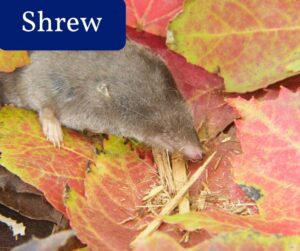 Shrews are similar to mice, but they have smaller eyes and an elongated, pointed snout. Shrews have denser fur, usually of a uniform color, either brown or gray. Shrews are more insectivorous than mice, and they are very aggressive hunters for their size. Much like moles and voles, shrews are rarely seen indoors, however, you might spot them inside garages or sheds. However, they prefer to live in leaf litter, under logs, or near foundations. Shrews are less destructive than mice, moles, or voles, but they can bite or scratch when handled.
Shrews are similar to mice, but they have smaller eyes and an elongated, pointed snout. Shrews have denser fur, usually of a uniform color, either brown or gray. Shrews are more insectivorous than mice, and they are very aggressive hunters for their size. Much like moles and voles, shrews are rarely seen indoors, however, you might spot them inside garages or sheds. However, they prefer to live in leaf litter, under logs, or near foundations. Shrews are less destructive than mice, moles, or voles, but they can bite or scratch when handled.
When To Call A Wildlife Professional
If you have mice, moles, voles, or shrews causing problems on your property in the Westchester area, contact the experts at Westchester Wildlife. Our team can correctly identify the type of critter you are dealing with, and begin working on a treatment plan, and once the animals are gone, we can offer exclusion work and preventative treatments to keep them from returning. Contact our team today to get started with a FREE estimate at (800) 273-6673!
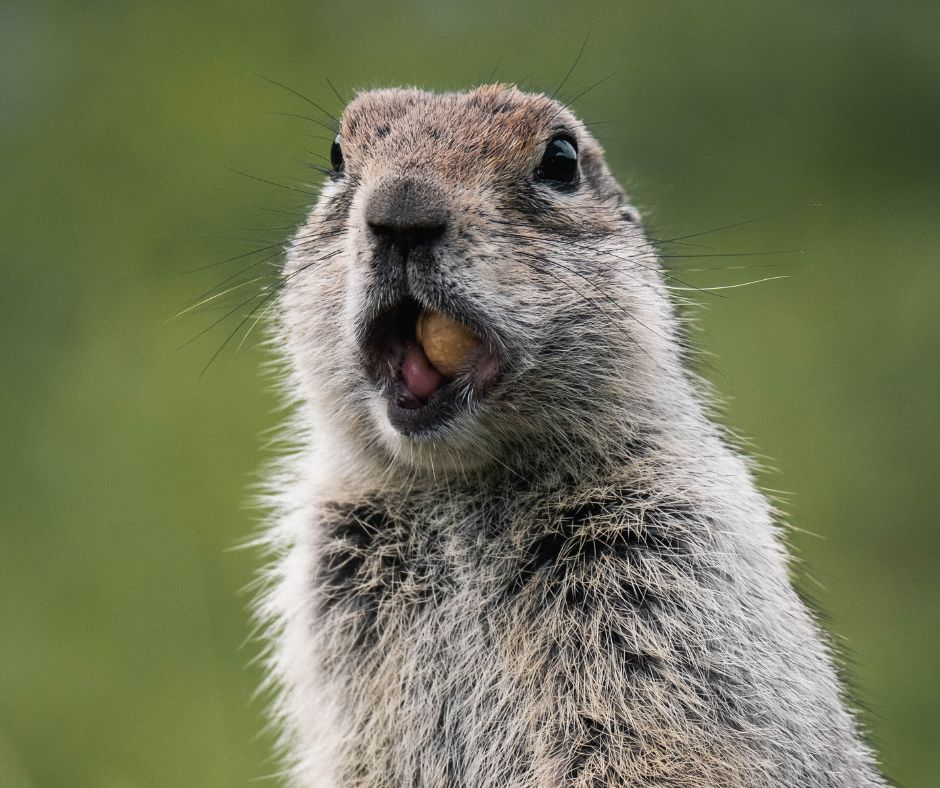 Are Groundhogs Tearing Up Your Yard? Here’s What You Can Do
Are Groundhogs Tearing Up Your Yard? Here’s What You Can Do
Are Groundhogs Tearing Up Your Yard? Here’s What You Can Do
Are you noticing soft, weak ground in your yard, a torn-up garden, large mounds of dirt, and holes underneath your deck or porch? You might have a groundhog problem. Groundhogs are a common nuisance wildlife in the Westchester, NY area during the spring and summer. It’s important to deal with a groundhog problem as soon as possible, as their destructive burrowing and feeding habits can quickly decimate your lawn and garden. This blog can help you recognize the early signs of a groundhog problem, as well as what steps to take so you can act fast and protect your lawn.
Why Groundhogs Love Your Yard
Groundhogs love your yard because it provides them with plenty of sources of food and shelter. Groundhogs are primarily herbivores, feeding on grass, garden vegetables, fruit, flowers, and ornamental plants, however groundhogs may also eat bird eggs and insects. Either way, whether it’s from a lush vegetable garden, a bird’s nest, or some insects passing through, your yard has what groundhogs are looking for.
Your yard also provides the perfect place for groundhogs to dig out their extensive burrows. Groundhogs nest in aerated soil to create temperature regulated homes that offer protection from predators like foxes and coyotes. Groundhogs usually prefer soil that’s loose and not too rocky for their burrows, and many landscaped yards can provide them with exactly that. Digging underneath solid structures like your deck or porch provides them with more cover and protection against predators, and they can also absorb more heat from your home’s foundation this way.
Signs That You Have A Groundhog Problem
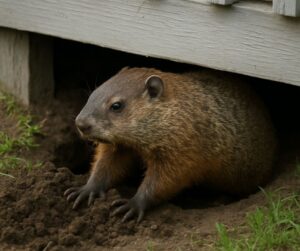 Some of the common signs that you have a groundhog problem in your yard in Westchester include:
Some of the common signs that you have a groundhog problem in your yard in Westchester include:
- Burrow entrances: groundhogs leave behind large holes at the entrance to their burrows, sometimes as big as 10-12 inches wide. You might also spot mounds of dirt nearby that were kicked up by the groundhog while digging.
- Missing garden plants: groundhogs will tear through your vegetable garden, happily taking all your hard work for themselves.
- Chewed flowers: groundhogs will also chew up flowers and other ornamental plants in your yard or garden.
- Weak or soft ground: groundhogs will quite literally hollow out your yard to dig their multi-chambered burrows. The ground above a burrow can feel weak or soft, like it might cave in at any time.
- Holes near foundation, deck, porch, or shed: groundhogs like to nest underneath your home’s foundation, deck, or porch, or underneath a shed, as these structures provide greater cover. Seeing large holes in the ground near the base of these structures can be a warning sign that you have groundhogs burrowing underneath them.
The Risks of Ignoring A Groundhog Problem
Groundhogs don’t go away on their own, and if you have a groundhog problem left unchecked, it can lead to serious consequences. Groundhogs can cause structural damage to your foundation, which can lead to it cracking and settling, which can lead to other issues like water damage and termites. If groundhogs are digging underneath your deck, it can cause the deck to slowly sink into the earth. Groundhog tunnels can also lead to cave-ins, which are a serious safety hazard. If you’re walking over a groundhog tunnel when it caves in, you can trip and may hurt yourself.
If you have a flourishing vegetable garden, groundhogs can destroy your crop yields year after year if they are not dealt with. It can make all your hard work feel like it’s going to waste when a groundhog is able to steal your tomatoes or carrots before you get a chance to try them. The same goes for flower gardens, or any other ornamental plants.
Why DIY Groundhog Deterrents Often Fail
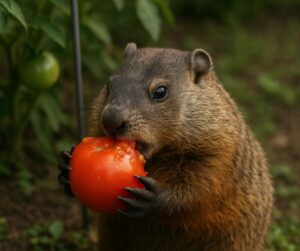 There are plenty of Do-It-Yourself deterrents for groundhogs on the market in Westchester, but some of them might not work as well as you want them to. Devices that use light, reflection, noise, or vibration might scare groundhogs off initially, but they will just come back once they realize there is no real danger. The same applies for scent-based repellents like castor oil.
There are plenty of Do-It-Yourself deterrents for groundhogs on the market in Westchester, but some of them might not work as well as you want them to. Devices that use light, reflection, noise, or vibration might scare groundhogs off initially, but they will just come back once they realize there is no real danger. The same applies for scent-based repellents like castor oil.
Unfortunately, DIY groundhog trapping also might fail, as groundhogs are very clever, and can evade traps set by a newcomer. Novice trappers can even make it harder for professional trappers, as they might be inadvertently training groundhogs to avoid common trapping methods. Don’t worry, if DIY groundhog removal/deterrent methods fail you, Westchester Wildlife is here to help.
Who To Call To Remove A Groundhog In Westchester
If you have a groundhog nesting on your property in Westchester, your best bet is to call a professional nuisance wildlife removal service like Westchester Wildlife. Animal control will only deal with animals that are on public areas like roads or parks, or animals that pose a direct safety threat like a rabid raccoon. For animals causing a nuisance like a groundhog burrowing under your porch, call Westchester Wildlife.
Humane and Effective Groundhog Removal in Westchester
If you are noticing groundhogs tearing your garden up and destroying your lawn in Westchester, contact the professionals at Westchester Wildlife for humane, effective groundhog trapping and removal services. Our technicians have years of experience dealing with groundhogs, so you can rest assured that we can catch these clever little critters. After the groundhogs are gone, we can provide you with wildlife fencing around the perimeter of your yard, around your foundation, or underneath your deck or porch, buried a few feet deep to keep groundhogs from digging underneath it. Contact our crew to get started today with a FREE estimate at (800) 273-6673!
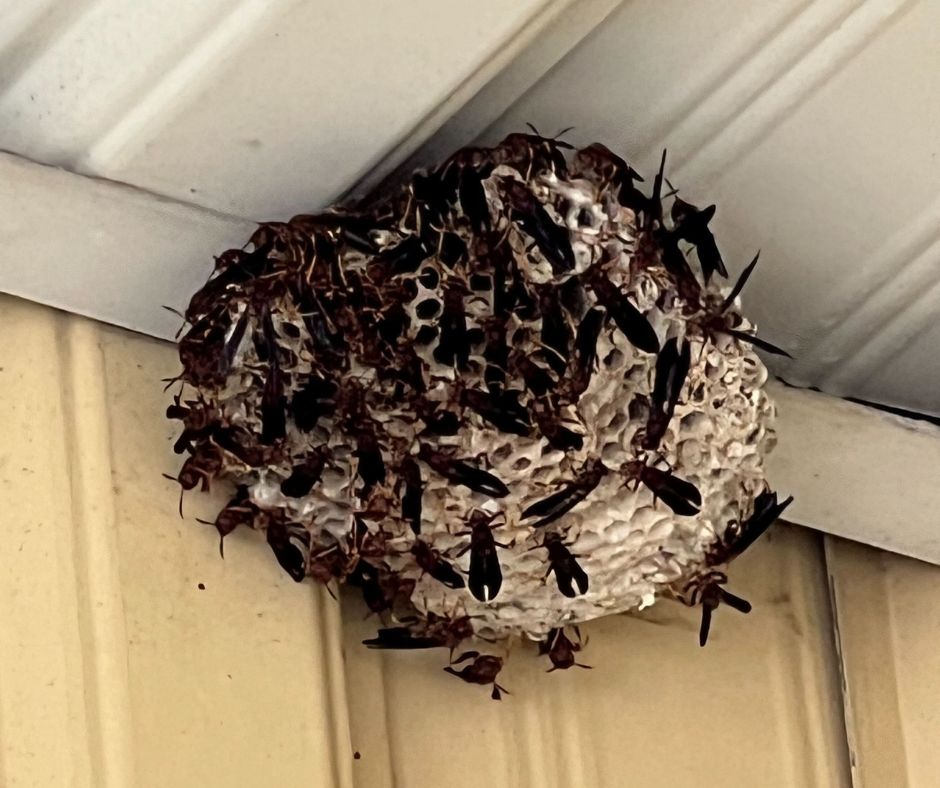 Your Guide to Spring Wasps and Hornets
Your Guide to Spring Wasps and Hornets
Your Guide to Spring Wasps and Hornets
During the springtime, stinging insects like wasps and hornets will build nests on your deck or porch, on your eaves, and even inside your attic space. Wasps and hornets are known for delivering painful, powerful stings, more than once, whenever something gets too close to their nest. This can be a serious issue when they are nesting on your property, and attempting to remove their nests yourself can be dangerous, as wasps and hornets will often swarm, delivering dozens of stings. If you have stinging insects nesting on your property, contact the experts at Westchester Wildlife for professional wasp and hornet nest removal services today. Our team of technicians are armed with the proper tools and training to safely remove wasp and hornet nests without any stinging incidents.
Types of Stinging Insects in Westchester County
Westchester County is home to several different types of stinging insects that can come into conflict with people, including:
- Paper Wasps: These wasps are large, often colored black and yellow, brown, or orange, with a thin waist and long legs that hang down while they fly. Paper wasps create nests out of paper and saliva that hang in an upside-down umbrella shape on porches, decks, vents, attics, and garages
- Yellowjackets: smaller wasps that are bright yellow and black, known for their aggression, painful stings, and tendency to swarm. Yellowjackets will build their nests high up in trees, or underground, near your foundation. You might spot yellowjackets flying in and out of a hole in the ground near your foundation.
- Bald-faced hornets: black-and-white hornets that build their large paper nests on the corners of homes, on light fixtures, or inside attics.
- Mud daubers: very thin black wasps with yellow legs that can be found inside wood siding or shingles. Mud daubers are aggressive, and should be avoided.
How To Keep Wasps Away From Your Home and Yard
If you want to keep wasp nests out of your attic space, the best thing to do is to have a licensed professional inspect your roof, soffit, fascia board and rake board for any potential gaps or cracks that could allow wasps in, and then sealing and fortifying these potential entry points. Keeping wasp nests off your porch, deck, or trees are a bit more difficult. Wasps are attracted to leftover garbage, food sources, and any water they can find, so sealing off your garbage cans, storing and disposing of food properly, and removing bird baths and other water sources can help make your yard less inviting to wasps and hornets.
The best way to keep wasps and hornets away from your yard is to have a regular pest control program done to deter stinging insects from building nests near your home.
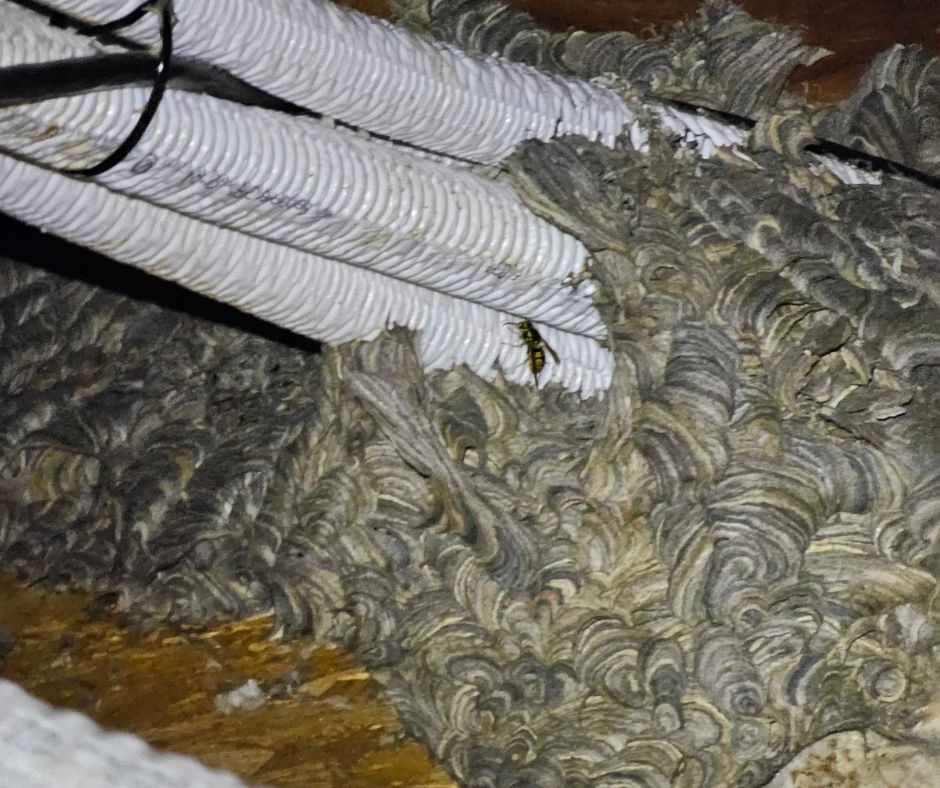
What To Do When You Find a Wasp Nest
When you spot a wasp or hornet nest on your property, it’s important not to disturb it. Wasps and hornets are both known for their aggression, and if you disturb their nests, they may swarm and sting you. DIY wasp removal can be very dangerous, and even life-threatening if you are allergic to wasp venom. Unfortunately, many DIY wasp control products are ineffective, or can be dangerous to the ecosystem if applied incorrectly.
The best thing to do when you find a wasp nest is to call a licensed wildlife removal company like Westchester Wildlife. Our team is highly trained, and has the tools and chemicals needed to safely remove wasp nests from your home without any stinging incidents. The best part is, most wasps and hornets can still sense a wasp nest used to be there, and will tend to avoid building a nest in the same location.
Best Wasp and Hornet Removal in Westchester County
Wasps and hornets are a very common sight in Westchester County in the spring. As soon as the snow melts and the temperatures rise, stinging insects will be looking to build their nests on light fixtures, porches, decks, inside attics, and even underground.
DIY wasp and hornet nest removal is extremely dangerous, and never recommended. Wasps and hornets will often become aggressive when their nests are threatened and will swarm and sting you.
Westchester Wildlife can help, our team of highly-trained pest control professionals will utilize industry-grade pesticides and other tools to safely remove stinging insect nests from your property, without any danger of a stinging incident. Get in touch with our team today for a FREE estimate at (800) 273-6673!
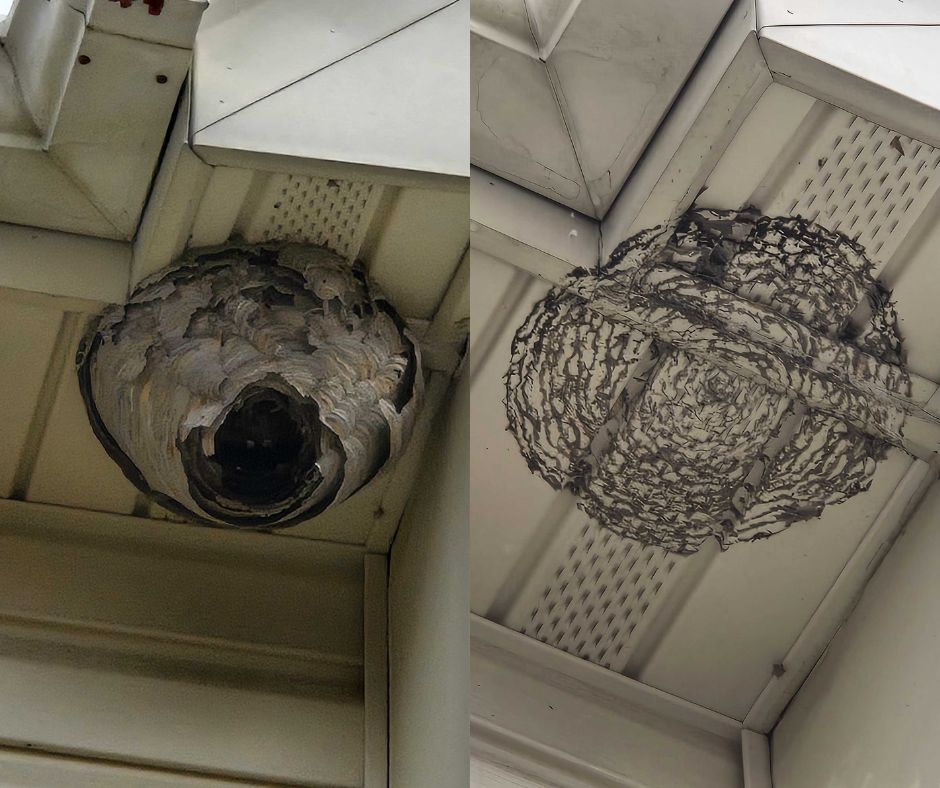
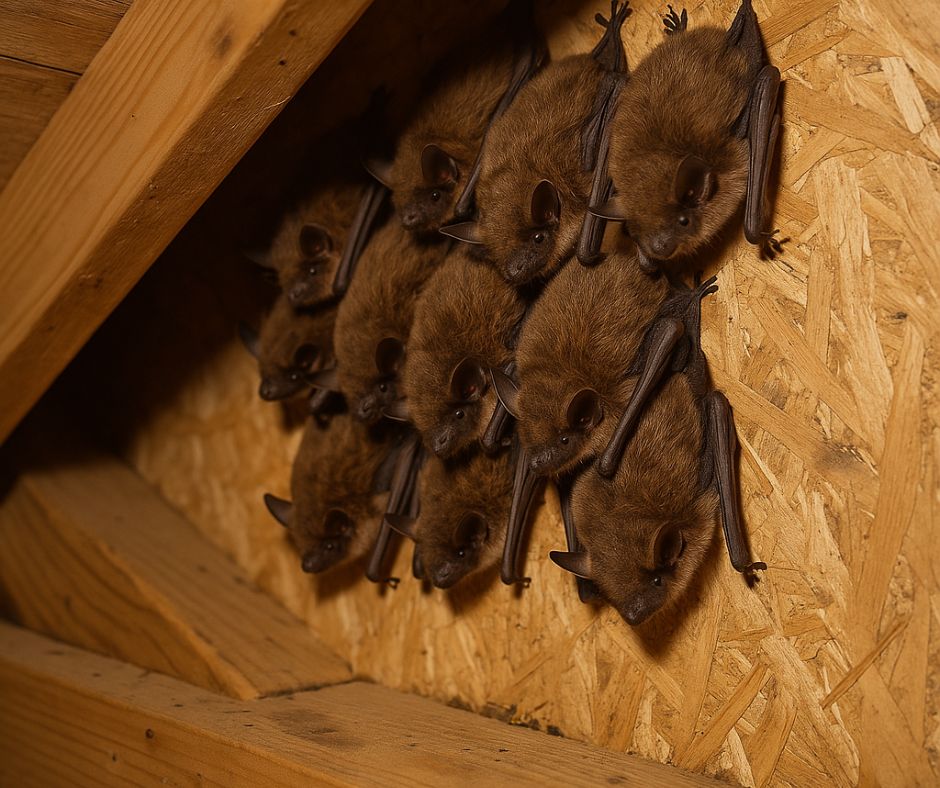 Common Myths About Bats DEBUNKED!
Common Myths About Bats DEBUNKED!
Common Myths About Bats DEBUNKED!
Bats are a very misunderstood species, and due to unfair depictions in storytelling and pop culture, they have garnered a bad rap. However, bats are a very beneficial species that is crucial to the environment! While bats can be dangerous when they get inside your home, they are also federally protected, so it’s important to treat them with care. Westchester Wildlife can help, we offer safe, humane bat removal and exclusion services in the Westchester County area. We utilize the industry-tested Bat-cones and Pro-cones to safely let bats out of your home or commercial property, without allowing them to get back in. Contact our team to get started today at (800) 273-6673!
Myth: All Bats Suck Blood!
False! While vampire bats do exist, they are only a small subspecies that are found in Central and South America. In these countries, vampire bats rarely feed on humans, instead choosing to feed on livestock, birds, or wild animals. None of the bats native to the United States feed on blood. Instead, native bats like the Little Brown Bat and the Hoary Bat feed on insects, fruit, and plant nectar.
Myth: Bats Will Attack Me or Fly Into My Hair!
False! Bats are non-confrontational, and prefer to avoid humans whenever possible. If a bat swoops down close to you, it is most likely trying to catch a mosquito or other insect, and is not trying to hurt you. Bats may bite or scratch, but only when they are cornered/are being handled, which you should NEVER do.
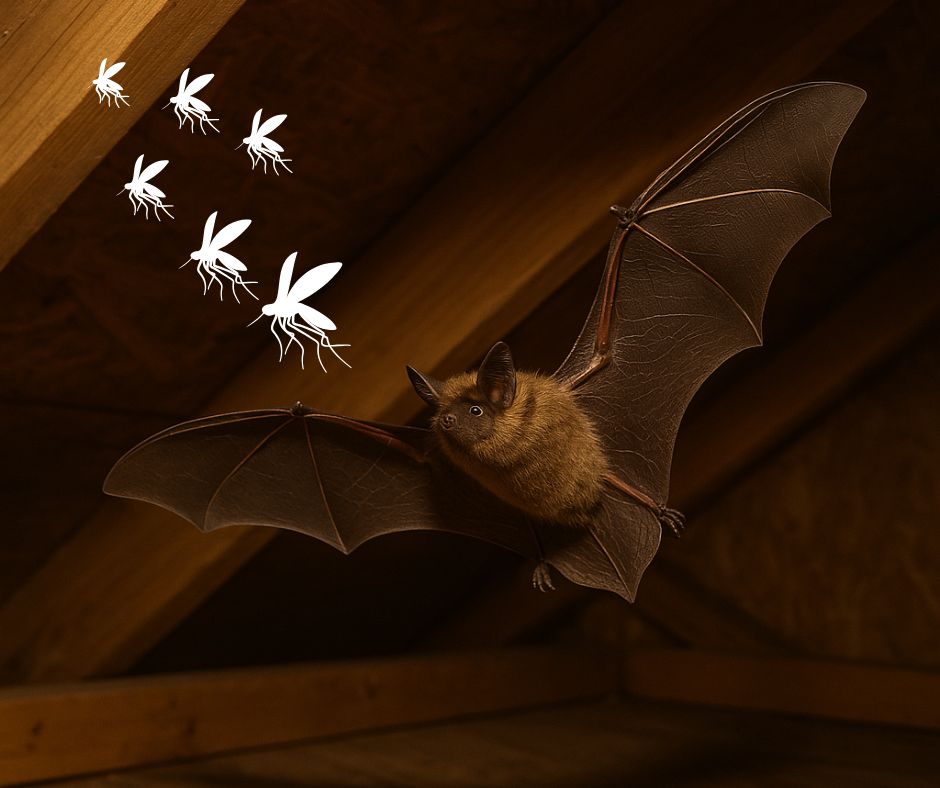
Myth: All Bats Have Rabies!
Nope! Less than 1% of bats test positive for rabies. However, bats are the most commonly reported animal to have rabies, and bats are responsible for most rabies deaths in the United States, so it’s important to treat any bat exposure as a potential rabies exposure. If you see a bat active during the day, a bat found in an unusual space, or a bat that is unable to fly or easily approached, be very cautious and contact animal control immediately as these are often signs of rabid bats. Another reason why bats are able to spread rabies so easily is because they have very small teeth and claws, so their bites and scratches can often go unnoticed.
Myth: Bats are Blind!
Not true! While many people think that bats are totally blind and only rely on echolocation, that could not be farther from the truth! Bats do have very small eyes and sensitive vision that is adapted to see in the dark, as bats are mostly active at nighttime. Their vision allows bats to interact with each other, avoid predators, and navigate across the sky. Echolocation, the process of emitting high-pitched sounds and interpreting echoes, is a mostly supplemental tool used to find insect prey and to navigate.
Myth: Bats Aren’t Beneficial
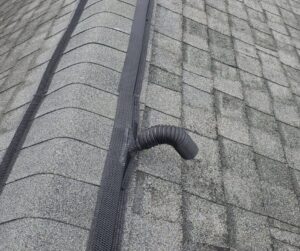 Incorrect! Bats are EXTREMELY beneficial to humans and the environment! Bats are excellent pollinators, crucial for the production of over 500 plants, including several important crops like bananas and mangos. In addition to their excellent pollinating, bats are also excellent pest control agents, able to eat as many as 1200 mosquitoes or mosquito-sized insects in a single hour! Bats are crucial to our ecosystem, but they unfortunately are in danger. Bat populations have been dying off due to encroaching human habitats and the spread of white-nose syndrome. This is why bats are federally protected, and must be handled with care. If you have bats nesting inside your attic, contact the experts at Westchester Wildlife. Our company’s owner and founder Jim Driesacker invented the bat-cone, a humane bat exclusion device that allows bats to leave your attic, but not get back inside. Our team utilizes bat-cones to safely remove bats from your attic without any harm. Get in touch with our team today to get started at (800) 273-6673!
Incorrect! Bats are EXTREMELY beneficial to humans and the environment! Bats are excellent pollinators, crucial for the production of over 500 plants, including several important crops like bananas and mangos. In addition to their excellent pollinating, bats are also excellent pest control agents, able to eat as many as 1200 mosquitoes or mosquito-sized insects in a single hour! Bats are crucial to our ecosystem, but they unfortunately are in danger. Bat populations have been dying off due to encroaching human habitats and the spread of white-nose syndrome. This is why bats are federally protected, and must be handled with care. If you have bats nesting inside your attic, contact the experts at Westchester Wildlife. Our company’s owner and founder Jim Driesacker invented the bat-cone, a humane bat exclusion device that allows bats to leave your attic, but not get back inside. Our team utilizes bat-cones to safely remove bats from your attic without any harm. Get in touch with our team today to get started at (800) 273-6673!
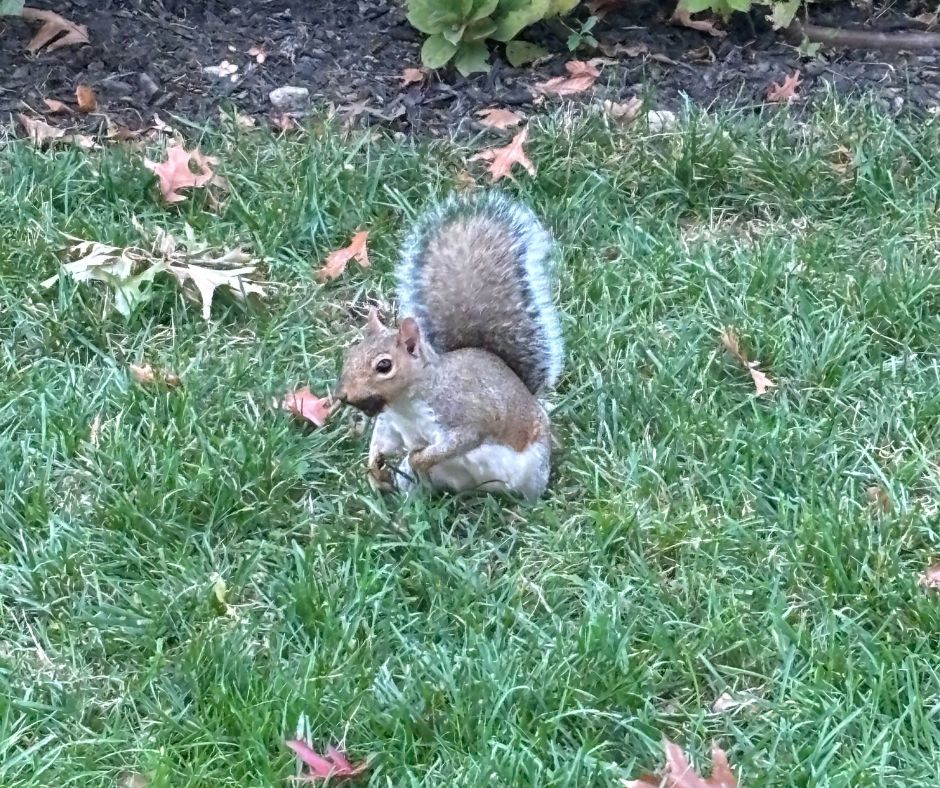 Are Squirrels Dangerous?
Are Squirrels Dangerous?
Are Squirrels Dangerous?
Squirrels scurrying across fences and along tree branches are a very common sight for homeowners in Westchester County. Squirrels can be spotted running across rooftops and getting close to porches and decks. While squirrels may look cute, the damage they do to your home and the diseases they can spread are anything but.
Squirrels can tear out your attic insulation and chew through wires, creating a fire risk. Squirrels can also spread diseases like tularemia, as well as parasites like ticks and fleas. If you need squirrels trapped and removed from your attic in Westchester, contact the experts at Westchester Wildlife today to get started at (800) 273-6673!
Why Squirrels Invade Homes
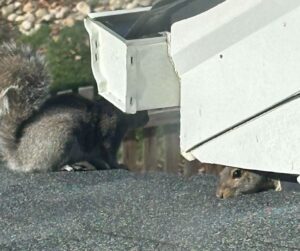 Squirrels are looking for the same thing that all living creatures need to survive: food, water, and shelter. Your attic space provides a perfect place for squirrels to nest, as it is safe, warm, secluded, and protected against predators and the elements. Trees or bird feeders may provide a source of food to hungry squirrels, and your wall voids can provide a spot for squirrels to stash their food for retrieval during the winter months.
Squirrels are looking for the same thing that all living creatures need to survive: food, water, and shelter. Your attic space provides a perfect place for squirrels to nest, as it is safe, warm, secluded, and protected against predators and the elements. Trees or bird feeders may provide a source of food to hungry squirrels, and your wall voids can provide a spot for squirrels to stash their food for retrieval during the winter months.
When getting inside your house, squirrels will exploit any cracks, gaps, or weak spots they can find, usually on damaged soffits, ridge vents, or weakened/missing roof shingles. Squirrels can even enter through your chimney. Once the squirrels have gotten inside, they will begin wreaking havoc on your home.
How Much Damage Can A Squirrel Do To A House?
Squirrels are small, but they have sharp teeth and claws that enable them to do more damage than you might expect.
- Chewing and Gnawing: squirrels have teeth that never stop growing, which means they need to constantly be gnawing on wooden beams, soffits, and rubber wire coverings to file down their teeth and keep the length manageable.
- Electrical hazards: when squirrels chew on the rubber covering surrounding wires, they can expose the bare wiring to the insulation, which can pose a fire hazard.
- Structural damage: over time, squirrels can weaken attic beams by chewing through them, creating structural instability.
- Insulation problems: squirrels will rip out your insulation to make their nests, and they will also soil it with their urine and droppings
Are Squirrels Dangerous to Humans?
Squirrels are rarely aggressive and prefer to stay out of the way of humans, but if they are cornered or trapped, they may lash out with their claws and teeth. That’s why it’s always best to leave squirrel removal to the professionals. Wildlife professionals will have the tools and equipment to safely remove squirrels without harm to either party.
Squirrels can also spread various diseases, including tularemia, leptospirosis, salmonellosis, and more. Squirrels also carry parasites like ticks and fleas, which can spread Lyme disease and Rocky Mountain Spotted Fever.
Signs of a Squirrel Infestation
Recognizing the signs of a squirrel infestation can help you get the situation under control faster. Some things to look out for include:
- Scratching or scampering noises coming from inside the attic, typically during the day as squirrels sleep at night
- Chewed and shredded insulation in the attic, or gnaw marks on wooden beams
- Holes in your soffit, missing shingles, bent roof vents
- Smell of droppings or urine coming from the attic
- Squirrels on your roof
What to Do If You Have A Squirrel Problem
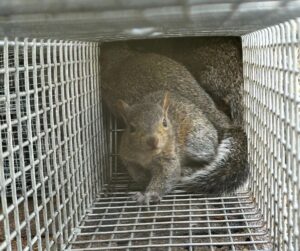 If you have a squirrel problem on your property in Westchester, don’t attempt to remove them yourself. Squirrels are unpredictable wild animals, and can become aggressive if threatened, especially when their babies are nearby. Squirrels are also adept at hiding their babies within attic insulation, and you might accidentally leave one behind when evicting a squirrel family. Wildlife removal professionals have the proper tools, training, and equipment to safely and carefully remove squirrels from your home in Westchester.
If you have a squirrel problem on your property in Westchester, don’t attempt to remove them yourself. Squirrels are unpredictable wild animals, and can become aggressive if threatened, especially when their babies are nearby. Squirrels are also adept at hiding their babies within attic insulation, and you might accidentally leave one behind when evicting a squirrel family. Wildlife removal professionals have the proper tools, training, and equipment to safely and carefully remove squirrels from your home in Westchester.
Animal control typically will not come out to deal with a squirrel infestation in your attic, as they deal with animals on public property like roads and parks, or animals that pose direct threats to people like a rabid raccoon. The best way to solve your squirrel problem is to contact a private wildlife removal service like Westchester Wildlife.
Best Squirrel Removal Service in Westchester
Westchester Wildlife offers the best squirrel removal service in Westchester County. Squirrels are a very destructive nuisance critter that can cause severe damage to your property when they nest inside your attic space. Westchester Wildlife can help, our team will safely remove squirrels, using humane live-traps and exclusion techniques. Our technicians will ensure all baby squirrels are removed with their parents and none are left behind. After the squirrel family is gone, our team can clean up their nesting material and seal off all current and potential entry points, preventing the squirrels from getting back inside in the future. Contact us today to get started with squirrel removal at (800) 273-6673!
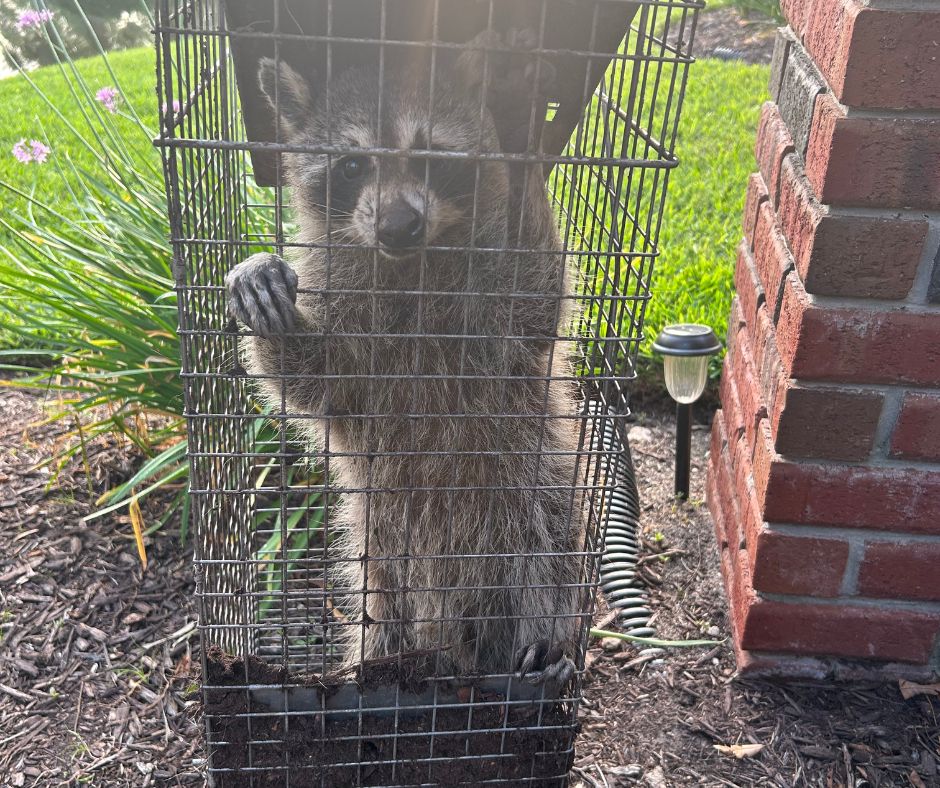 The Benefits of Professional Wildlife Removal Services vs DIY Methods
The Benefits of Professional Wildlife Removal Services vs DIY Methods
The Benefits of Professional Wildlife Removal Services vs DIY Methods
An unfortunate reality of owning a home is that you have to deal with the occasional pest infestation, or even a wildlife problem. Critters like raccoons, squirrels, bats, and more will break their way into your home, often choosing your attic as a nesting spot. In addition to critters in your attic, scavengers like raccoons, opossums and foxes are known to knock over your outdoor trash cans, throwing trash across the lawn. Groundhogs will burrow underneath your home’s foundation, causing it to crack and settle. Moles will dig tunnels in your lawn, ripping up the grass and destabilizing the soil. When dealing with nuisance wildlife concerns, it’s important to act as quickly as possible, as the problem will not go away with time; it will get worse. When dealing with a nuisance wildlife infestation, many homeowners want to go the DIY route initially. However, wildlife removal presents many challenges and dangers, and should always be left to professionals. If you need nuisance wildlife removal services in Westchester County, Putnam County, or Dutchess County, contact the experts at Westchester Wildlife today for a FREE estimate at (800) 273-6673!
The Risks and Limitations of DIY Wildlife Removal
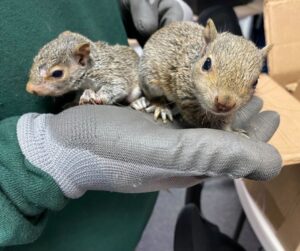 Removing an animal from your property may sound tempting, but it poses several risks that you might not consider. Raccoons are armed with sharp claws and teeth, and are known to lash out and injure people, especially if they are accompanied by their young. Raccoons are adept at hiding their babies deep inside the insulation, and the untrained eye can miss one or two of the babies when evicting a raccoon family. Raccoons are also a common carrier of the rabies virus.
Removing an animal from your property may sound tempting, but it poses several risks that you might not consider. Raccoons are armed with sharp claws and teeth, and are known to lash out and injure people, especially if they are accompanied by their young. Raccoons are adept at hiding their babies deep inside the insulation, and the untrained eye can miss one or two of the babies when evicting a raccoon family. Raccoons are also a common carrier of the rabies virus.
Bats also carry rabies, and even handling a bat can be counted as a potential rabies exposure. Bats are also endangered and under protection from federal law, and mishandling or killing them can incur serious fees. Skunks are not easy to remove, as they will use their signature spray defense, which causes a horrible odor that is very difficult to get rid of. Squirrels and groundhogs can also become aggressive when cornered, and they can spread diseases like tularemia and leptospirosis. Even removing bat guano can pose a risk, as bat guano contains the spores that cause the fungal lung infection histoplasmosis.
In addition to the safety risks, you might run into limitations when attempting to remove wildlife on your own. Store bought traps can be ineffective if not placed correctly, especially with groundhogs. Many “repellents”, from sprays to flashing light devices and noise makers are either ineffective, or only effective for a short time. Wildlife can adapt to lights and sounds easily, as soon as they realize it doesn’t pose an actual threat.
The Advantages of Hiring a Professional Wildlife Removal Service
Hiring a professional wildlife removal service to deal with your wildlife problem offers several advantages over doing it yourself. Professional wildlife technicians are armed with professional equipment and traps, including proper safety equipment. Professional wildlife removal technicians also ensure that all federal and local laws and ordinances are followed during the process, and that all animals involved are treated humanely. Relying on professional services also minimizes the risk of disease transmission, protecting you from rabies, histoplasmosis, and other zoonotic diseases.
When you hire a nuisance wildlife professional, they can provide you with long term solutions that address the underlying problem. This can involve exclusions, seal-outs, repairing leaks, fixing wildlife damage, and more.
Cost Comparison: DIY vs. Professional Services
Many people jump at the chance to do DIY wildlife removal because it costs less in the short term, but did you know that professional wildlife removal services can actually save you much MORE money in the long run?
DIY efforts may have cheaper upfront costs, but because DIY wildlife removal is often ineffective, you might be stuck paying that cost over and over again. Critters like raccoons are armed with seriously dangerous claws and teeth, and if your attempt to remove a raccoon goes south, you might have to pay for medical bills. If you remove the wildlife from your home or yard improperly, they could come back and create even more structural damage, costing you more money for repairs. Professional wildlife removal services ensure that your wildlife problem is safely dealt with, and your property is safeguarded against future infestations, making it much cheaper in the long run.
When to Call a Professional
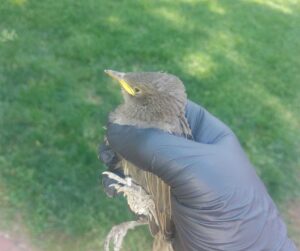 Knowing which situations require a wildlife removal professional can save you time and energy. Wildlife professionals are most helpful for dealing with animals that are living on your property or spending lots of time near your property. Raccoons, squirrels and bats living in your attic, a venomous snake in your garden or crawl space, moles tearing up your yard, a skunk building a den under your porch, all of these situations would require a wildlife professional. However, if a raccoon is just simply passing through your yard, or if a squirrel is running across your fence, you can wait it out and see if they stick around before contacting a wildlife removal company. Most of the time, without any food sources or easy shelters, critters in your yard will just move on.
Knowing which situations require a wildlife removal professional can save you time and energy. Wildlife professionals are most helpful for dealing with animals that are living on your property or spending lots of time near your property. Raccoons, squirrels and bats living in your attic, a venomous snake in your garden or crawl space, moles tearing up your yard, a skunk building a den under your porch, all of these situations would require a wildlife professional. However, if a raccoon is just simply passing through your yard, or if a squirrel is running across your fence, you can wait it out and see if they stick around before contacting a wildlife removal company. Most of the time, without any food sources or easy shelters, critters in your yard will just move on.
Wildlife removal professionals also do not deal with domestic animals like dogs and cats, or animals that are on public property like roads or parks, as both of these situations are problems for animal control. However, if an animal dies on your property, then dead animal removal does fall under wildlife removal services.
If you need professional wildlife removal in Westchester County, Putnam County, or Dutchess County, contact the experts at Westchester Wildlife. Our team of highly trained wildlife technicians are armed with the tools, training, and experience to safely and humanely remove nuisance critters from your property. Get in touch with our office today to get scheduled at (800) 273-6673!
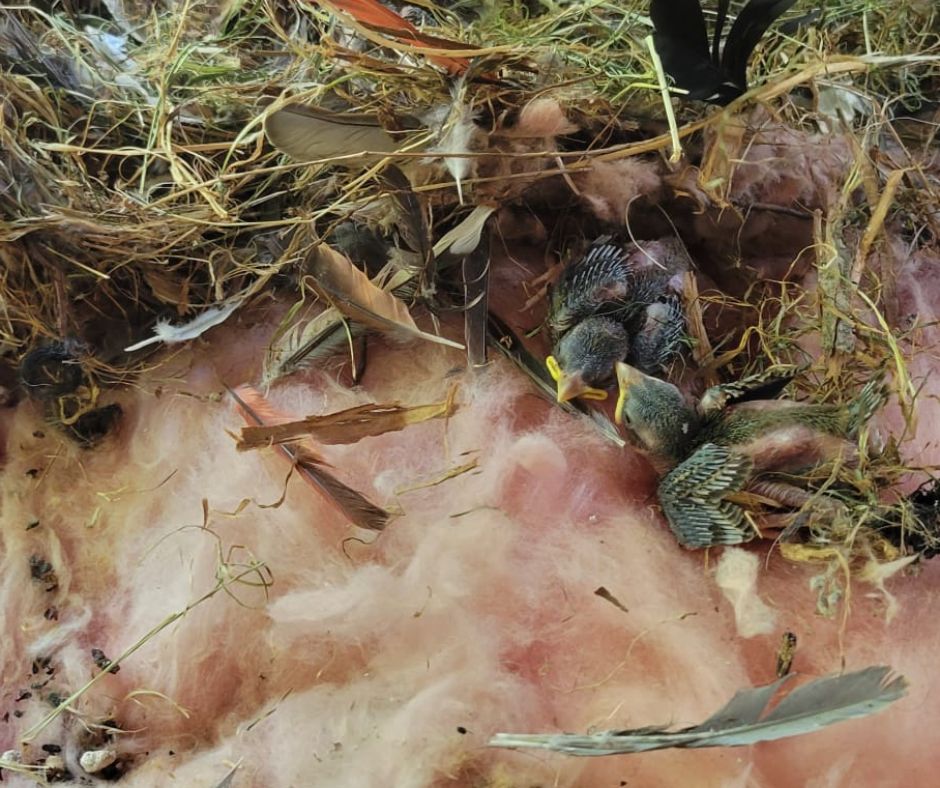 When To And When NOT To Call A Professional Wildlife Removal Company
When To And When NOT To Call A Professional Wildlife Removal Company
When To And When NOT To Call A Professional Wildlife Removal Company
When faced with a nuisance wildlife situation, you might find yourself wondering who you can call to help you out. We commonly receive calls from people across the Westchester County area that are wondering who they need to get in contact with to deal with the distressing situation at hand. Animal control and wildlife removal provide different services, as animal control won’t deal with animals on private property, and wildlife removal companies won’t deal with domestic animals. If you have a nuisance wildlife situation inside your attic, crawl space, or anywhere else on your property, contact the experts at Westchester Wildlife! Our team has the tools and the training to safely and humanely remove raccoons, squirrels, bats, chipmunks, groundhogs, and more!
Domestic Animals and Feral Cats
Professional wildlife companies do not deal with domestic animals. Domestic animals include cats, dogs, and all other animals that are kept as pets and not native to the area. If you have a colony of feral cats on your property, these would actually be under the jurisdiction of animal control. Similarly, if you have a lost dog, or if you have seen a dog running free through your neighborhood, that is also a situation for animal control. Westchester Wildlife does NOT deal with dogs, cats, or any other domestic animal.
Wildlife Inside Your Attic
When you have wildlife inside your attic space, this is a perfect situation for a wildlife removal company. Raccoons, squirrels, opossums, bats, and rodents will break into your attic and nest inside your insulation, often ripping it up and soiling it.Unfortunately, when nuisance wildlife have taken up residence on your private property, they are no longer within the jurisdiction of animal control. DIY removal is not recommended, because raccoons and bats can spread the rabies virus through bites and scratches, and all of these animals can become aggressive when handled or cornered. If you have a nuisance critter inside your attic, your best bet is to contact a licensed wildlife removal company.
If you have birds like pigeons, sparrows, or starlings nesting inside your attic, or inside your home’s exterior vents like a dryer vent, removing these birds and their nesting material is under the jurisdiction of a nuisance wildlife company.
Rabid Animals/Animals on Public Property
If there is a rabid, aggressive animal, domestic or wildlife, that is posing a direct threat to people, then this is a case for animal control. If there’s a raccoon on public property like in the road or in a public park, this falls under animal control. The government is responsible for removing dead animals from the road, and from other public property. However, if a deer is hit by a car, wanders into your yard and then dies, it becomes your responsibility and falls under the jurisdiction of a wildlife removal company. Wildlife removal companies handle dead animal removal for nuisance critters like raccoons, squirrels, deer, and more.
Bees and Wasps | Mice and Rats
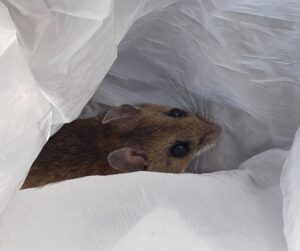 Bees and wasps are stinging insects that can become aggressive if they perceive you as a threat. This is worsened by the fact that bees and wasps often build their nests on porches, decks, and inside attic spaces, increasing the likelihood of a conflict with you. Bees and wasps are typically covered by pest control companies, however, Westchester Wildlife also offers bee and wasp nest removal services in the Westchester County area.
Bees and wasps are stinging insects that can become aggressive if they perceive you as a threat. This is worsened by the fact that bees and wasps often build their nests on porches, decks, and inside attic spaces, increasing the likelihood of a conflict with you. Bees and wasps are typically covered by pest control companies, however, Westchester Wildlife also offers bee and wasp nest removal services in the Westchester County area.
Similarly, issues with rodents like mice and rats tend to fall under the jurisdiction of both pest control companies and wildlife removal companies, as they are both pests and nuisance wildlife. If you have an issue with a rat or mice infestation in Westchester County, Putnam County, or Dutchess County, Westchester Wildlife can help! We offer the best rodent control and prevention services in the area.
Termites, Ants, and Other Pests
When it comes to insect pests like termites, ants, roaches, silverfish, and more, this falls squarely under the jurisdiction of a licensed pest control professional. While the Westchester Wildlife team can help with rodents and stinging insects, we do NOT deal with termites, ants, and other insect pests.
Animals In Your Yard/Under Your Deck
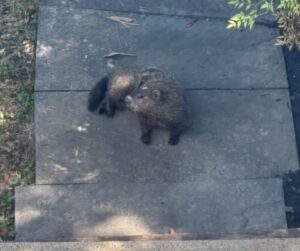 Attics aren’t the only area on your property that nuisance wildlife will hang out in. Groundhogs are known to dig extensive underground burrows on your property, which can destabilize the soil and lead to your foundation cracking and settling. Groundhogs are also infamous for decimating gardens, feeding on the vegetable crops within. Skunks and foxes are known to dig out dens underneath porches, decks, and sheds. Moles and voles will also dig unsightly tunnels in your garden, with moles leaving behind kicked-up molehills of dirt, and voles leaving behind shallow trenches. You might also deal with opossums and rodents inside your crawl space, or raccoons inside your garage. When you have non-domestic wild animals causing trouble in areas of your property besides your attic, this is another situation where you would call a nuisance wildlife company like Westchester Wildlife.
Attics aren’t the only area on your property that nuisance wildlife will hang out in. Groundhogs are known to dig extensive underground burrows on your property, which can destabilize the soil and lead to your foundation cracking and settling. Groundhogs are also infamous for decimating gardens, feeding on the vegetable crops within. Skunks and foxes are known to dig out dens underneath porches, decks, and sheds. Moles and voles will also dig unsightly tunnels in your garden, with moles leaving behind kicked-up molehills of dirt, and voles leaving behind shallow trenches. You might also deal with opossums and rodents inside your crawl space, or raccoons inside your garage. When you have non-domestic wild animals causing trouble in areas of your property besides your attic, this is another situation where you would call a nuisance wildlife company like Westchester Wildlife.
Best Wildlife Removal Company in Westchester County
Whenever you need an issue with a nuisance wildlife problem resolved, whether it be a bat colony in your attic, a raccoon in your garage, a dead deer in your yard, or a groundhog digging up your garden, trust the wildlife removal experts at Westchester Wildlife. Our team of licensed wildlife removal experts will safely, carefully, and humanely help resolve your wildlife issue to protect both you and the animal. We service Westchester County, Putnam County, Dutchess County, Fairfield County, and more! Contact our team to get started today with a FREE estimate at (800) 273-6673!
